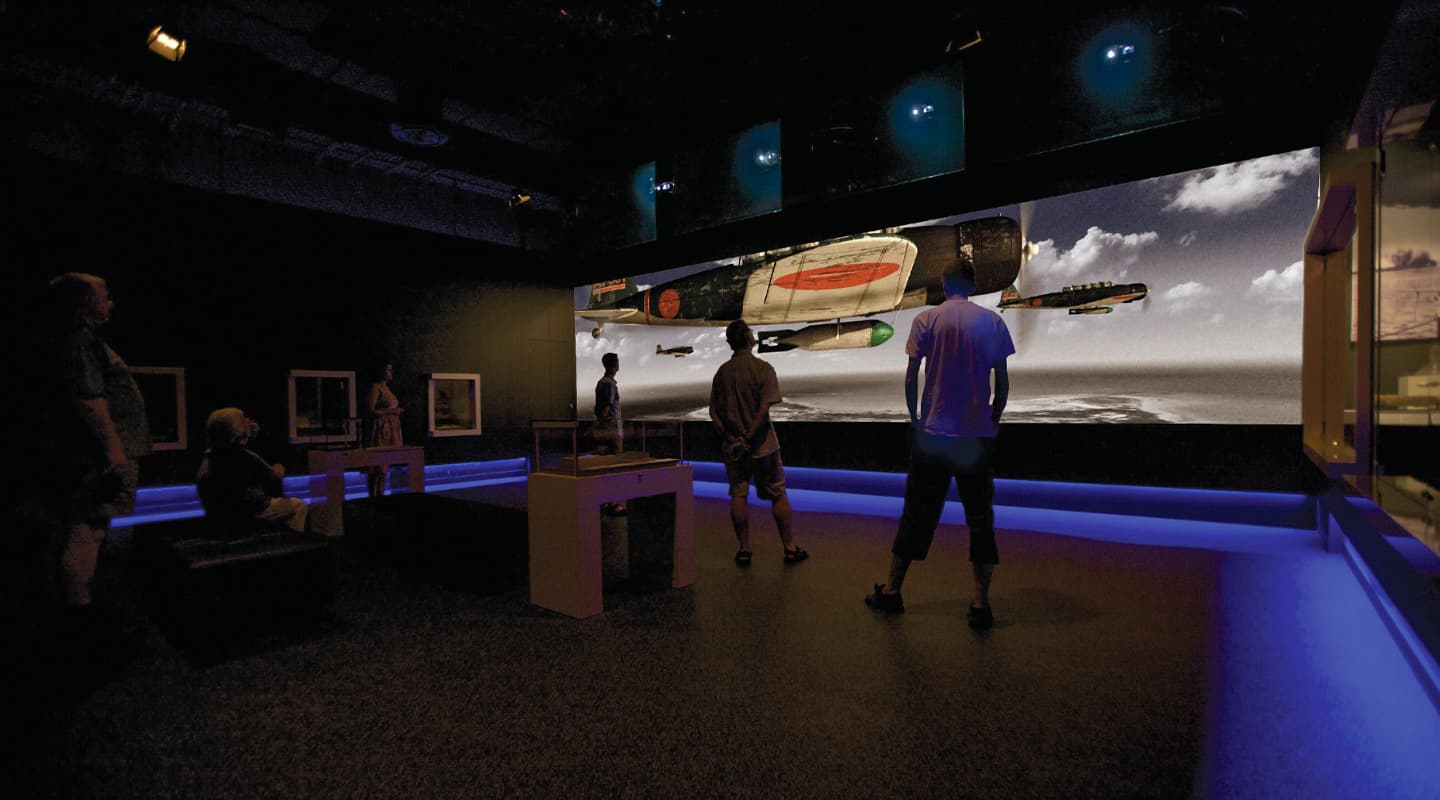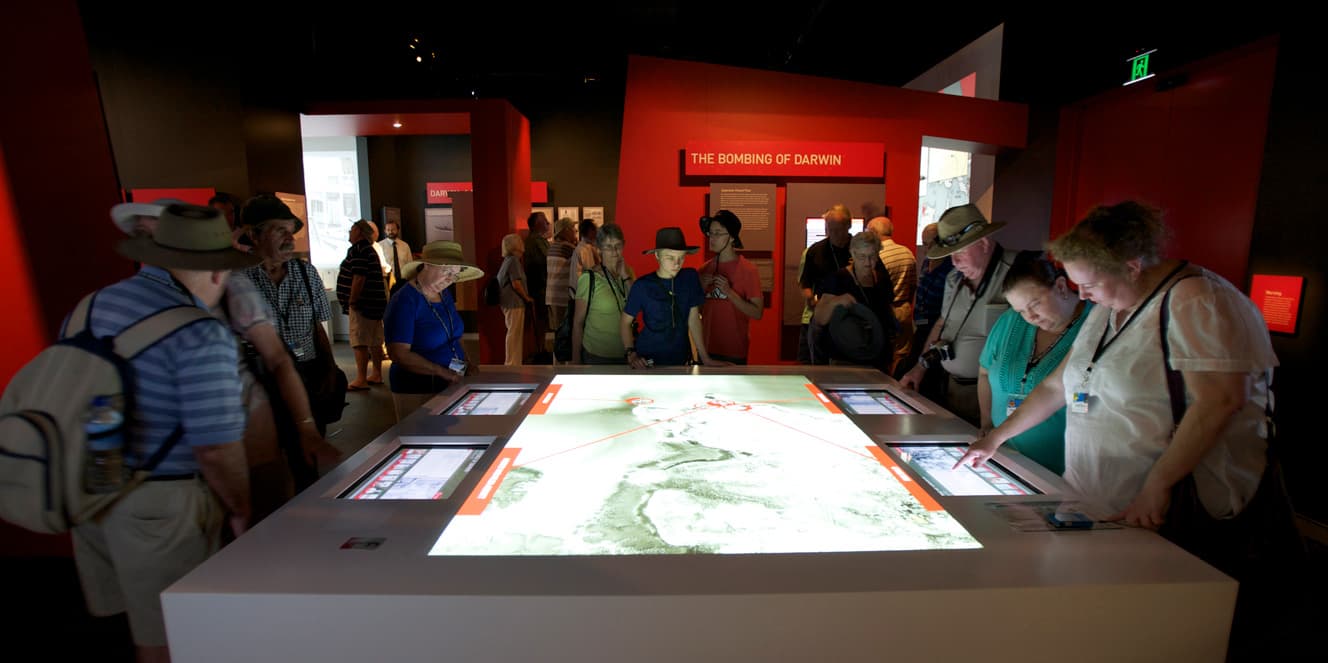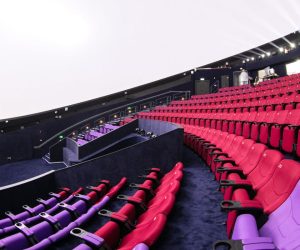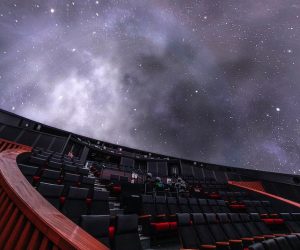
The Museum That Bombs
Actually, thanks to the sensitive and spectacular use of AV, The Defence of Darwin Experience is a big hit.

Text:/ Christopher Holder
Darwin is a curious place. I’ve never been, and I expect you’ve probably not been either. Darwin is the archetypical frontier town with crazy weather, crazy people, and the odd crazy idea. [Less than 25 registered AV readers, just so you know – Ed.] One crazy idea was to build a world-class museum that dramatises the story of the bombing of Darwin in World War II.
If like me, you thought the bombing of Darwin amounted to not much more than a couple of lost Japanese Zeros jettisoning their leftover bombs onto a footy oval, then it may surprise you that the event is even worthy of such an exhibit. Well, I guess this is exactly what the Defence of Darwin Experience (DODE) is all about, demonstrating to us ignorant southerners the gravity of this unique assault on our sovereignty. [My Dad was stationed there at the time, so we’re not all that ignorant – Ed.]
The Defence of Darwin Experience (DODE) is a $10 million museum. Exhibition designers Convergence Design engaged The Pod Multimedia to develop and produce all multimedia and interactive components, and DRM AV to integrate the audiovisual components. Unlike a typical museum, DODE uses the memories of the participants: soldiers, sailors, nurses, civilians and even Japanese commanders, which had been gathered over the years as oral histories. The POD and DRM’s challenge was to bring these stories to life in accessible and entertaining ways while conveying the ‘big picture’ story of the defence of Northern Australia, and while still being historically accurate according to strict curatorial guidelines – ie. ‘dramatic’ yet ‘accurate’. In all, there are three galleries comprising 17 audiovisual, multimedia and interactive programs. But the big-ticket AV programs include the Bombing of Darwin Experience and the Darwin Battlefront Table, both worthy of further investigation here.

MAXIMUM IMPACT
As visitors go about their business viewing artefacts in Gallery 3, something a little different occurs: movement sensors detect their presence and all hell breaks loose. A WWII air raid siren begins to wail, the large door starts to slide shut, the iGlass panels in front of the displays turn opaque and the room lights dim. So begins the Bombing of Darwin Experience, a multi-sensory audiovisual spectacle that tells the story of the bombing of Darwin by Japanese aircraft on February 19, 1942 – the first raid ever on Australian soil by foreign forces.
As a starting point, The POD digitally manipulated and animated contemporary archive photographs of Darwin – the images of the attacking planes and ships are accurate down to their livery, squadron colours and identification numbers. Historical accuracy has to be a priority in a museum context but The POD and DRM were just as concerned with immersing the viewer. The iGlass projection surface is a hefty 10m wide and 2.2m high, and the audio spec ensures the explosions have the requisite impact. Meanwhile, lighting effects simulate the flash of machine gun fire and the glow of buildings aflame.
Running the Bombing show is a reasonably complex affair what with synchronising multiple projectors, the iGlass switching from transparent to opaque, strobes, moving and display lighting, as well as a number of mechanical features such as electronic doors, all of which need to be functional up to 20 times a day, every day, without fail.
The POD and DRM devised a customised show control system to not only speed up the installation process but also to ensure the running of the show could be controlled and monitored remotely. The show control was built in Flash and fires off IP commands that the AMX control system accepts and translates. “That way if after the fact we need to dim the LED strip lighting or change colour or the like, we can change the timing of all that,” DRM’s managing director Brad Hogan pointed out.
In fact, given The POD Multimedia and DRM AV are both based in Melbourne, this ability to painlessly monitor, maintain and fine-tune the exhibits remotely has proven invaluable.
The iGlass was a particularly big hit on this job. Manufactured not so far from AV’s editorial offices in Mount Helen, Vic, DRM uses the transformative powers of the glass to indeed transform the visitor’s environment: one minute they’re viewing exhibits through a glass cabinet, the next they’re plunged into the noise and strobing disorientation of a simulated air raid with the glass acting as highly effective projection surface.

TABLED QUESTION
The Darwin Battlefront Table is the focal point of Gallery 2. It’s an interactive exhibit that takes the form of a map table, familiar to anyone who’s seen the start of Dad’s Army. But instead of a printed map, The POD used an actual photographic aerial view of Darwin taken in 1942 by the RAAF as a projection on the table surface (via a Panasonic HD projector). Around the periphery of the table are four ELO 22-inch touchscreens. On each of these is a menu of 27 people who were in Darwin at the time of the bombings. As you tap on one of the people listed, the aerial photograph animates and zooms in to where that person was on the day of the first raids.
As other visitors select people on the other touchscreens, the photograph animates and changes scale to show where their selected character was on the day. (If, by chance, all visitors at the table select one particular person, the photograph will zoom into an extreme close up of where that person was located.) As a person is selected from the menu, the visitor at that touch screen hears that character’s story taken from recorded oral histories.
Brad Hogan: “Interactive tables of this kind – that convey the quantity of info and respond to as many people as this – can be very expensive. So the idea of going with the four unique touchscreens and projection onto the table worked well – better than a GestureTek or MultiTouch solution, in our opinion. We didn’t have the budget for those types of solutions but this approach has proven to be very effective.”
The software running the application is a Flash-based program and the operation of the interactivity is similar to a website. A mainframe computer acts as a web server with four Apple Mac minis independently accessing information from the mainframe. Each visitor can interact and separately control what is happening on the projected table.
MISSION ACCOMPLISHED
I believe it’s significant that the curators of this museum comprehended one crucial point in making the DODE a compelling experience. Quite simply, it’s the personal accounts of those who were there. The audiovisual installation – although spectacular at times, and always well designed – is there to support those accounts. And perhaps this is where The POD and DRM AV deserve the biggest pat on the back: having the patience and sensitivity to track the ups, downs, and curveballs thrown by this project to achieve the right result.
The proof of the pudding is a wildly successful museum where attendances have far outstripped even the most optimistic expectations. Not bad in a time when audiences have ‘seen it all’ – whether that be Saving Private Ryan in the cinema or spending the entire weekend in front of Call of Duty. Clearly this is an audiovisual success story, and maybe… just possibly… reason enough for us lily-livered southerners to visit our nation’s northern capital.
GEAR HIGHLIGHTS
AMX controller
11 × NEC short throw projectors
5 × Mitsubishi short throw projectors
1 × Panasonic HD projector for the Darwin Battlefront Table
20 × Roku 1010 media players
15 touchscreens
18 × Windows/Mac computers
Video capture for story share exhibit
iGlass panels, lighting effects, door controller for the Bombing of Darwin Experience
5.1 Surround System
MORE INFORMATION
Defence of Darwin Experience: www.defenceofdarwin.nt.gov.au
The POD Multimedia: www.the-pod.com.au
DRM Audio Visual: www.drmav.com.au















RESPONSES